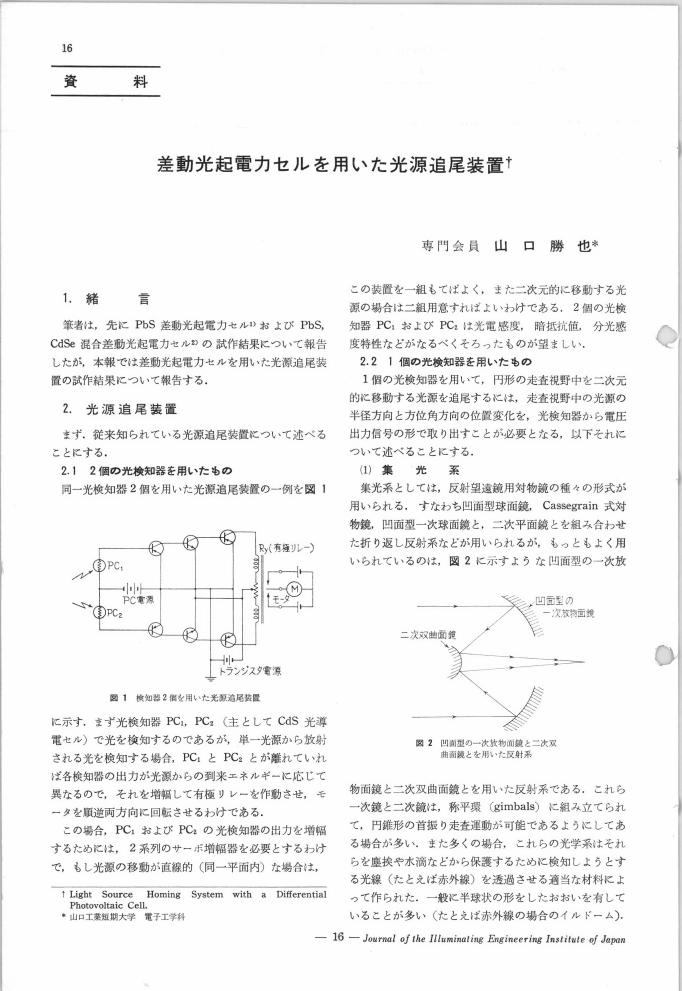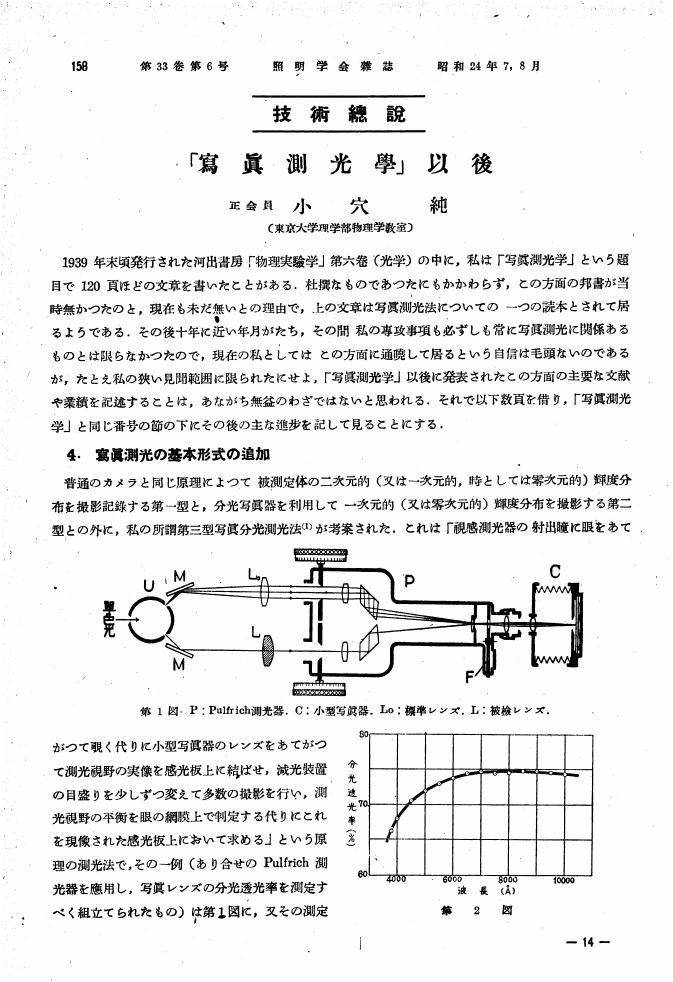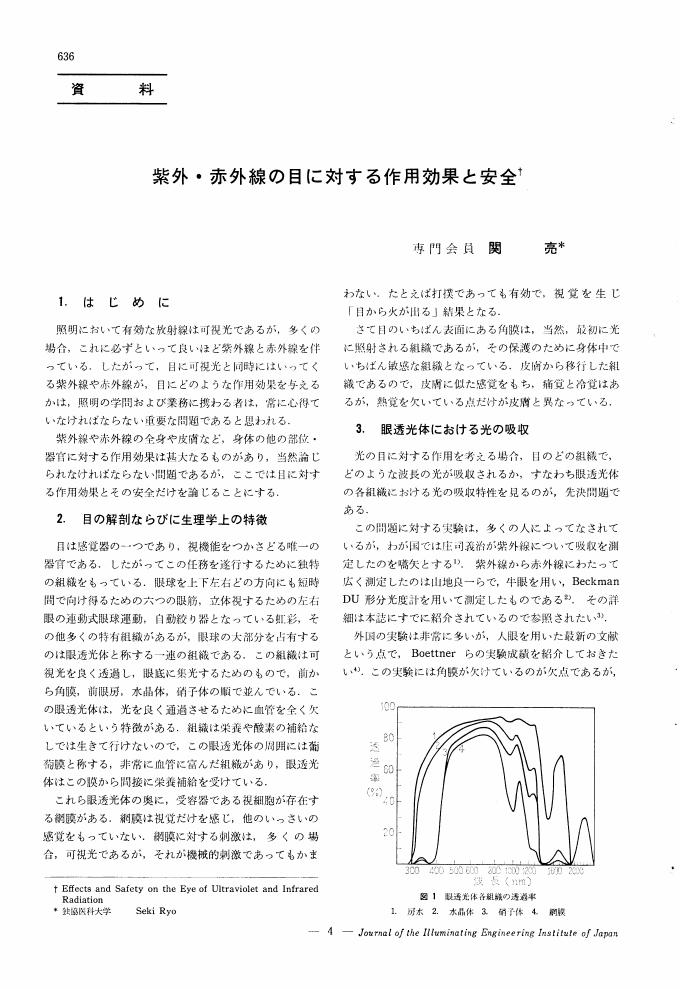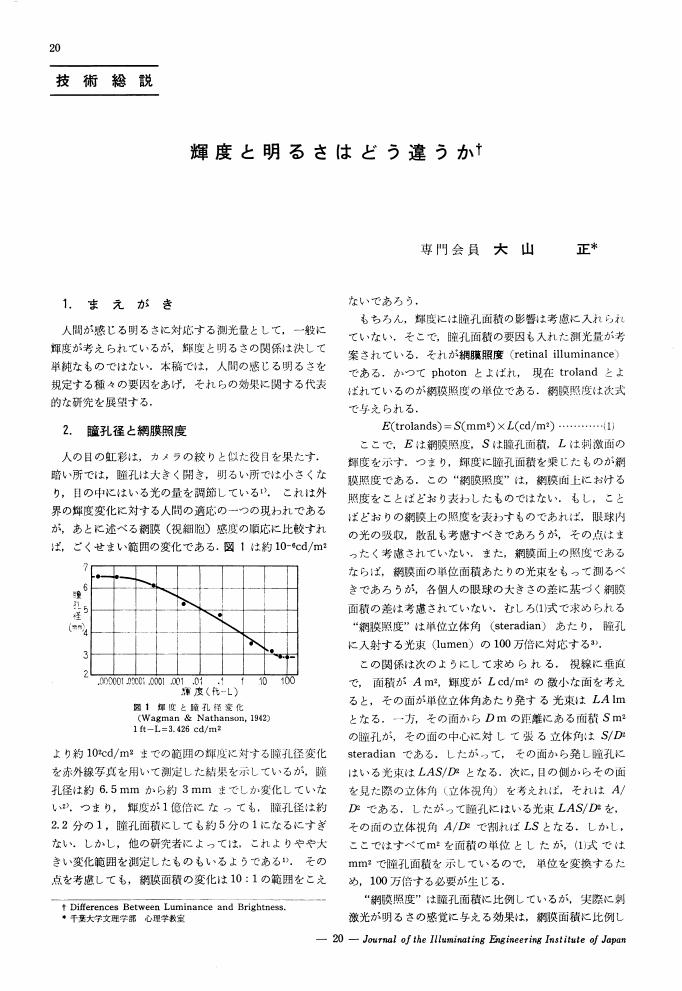22 0 0 0 OA 新大阪驛の照明設備に就いて
- 著者
- 熊谷 爲夫
- 出版者
- 一般社団法人 照明学会
- 雑誌
- 照明学会雑誌 (ISSN:00192341)
- 巻号頁・発行日
- vol.25, no.2, pp.8-25, 1941 (Released:2011-02-09)
10 0 0 0 OA 特急 『あさかぜ』 について
- 著者
- 石黒 寛 内田 重春 田中 正次 小山 茂雄
- 出版者
- 一般社団法人 照明学会
- 雑誌
- 照明学会雑誌 (ISSN:00192341)
- 巻号頁・発行日
- vol.43, no.5, pp.158-162, 1959-05-25 (Released:2011-07-19)
8 0 0 0 OA 照明教室
- 著者
- 正木 光
- 出版者
- 一般社団法人 照明学会
- 雑誌
- 照明学会雑誌 (ISSN:00192341)
- 巻号頁・発行日
- vol.43, no.2, pp.60-62, 1959-02-25 (Released:2011-07-19)
6 0 0 0 OA 明治・大正・昭和 (終戦まで) の照明工学の歩み
- 著者
- 関 重広
- 出版者
- 一般社団法人 照明学会
- 雑誌
- 照明学会雑誌 (ISSN:00192341)
- 巻号頁・発行日
- vol.51, no.8, pp.480-493, 1967-08-25 (Released:2011-07-19)
6 0 0 0 OA 差動光起電力セルを用いた光源追尾装置
- 著者
- 山口 勝也
- 出版者
- 一般社団法人 照明学会
- 雑誌
- 照明学会雑誌 (ISSN:00192341)
- 巻号頁・発行日
- vol.52, no.1, pp.16-19, 1968-01-25 (Released:2011-07-19)
- 参考文献数
- 3
6 0 0 0 OA 「寫眞測光學」以後
- 著者
- 小穴 純
- 出版者
- 一般社団法人 照明学会
- 雑誌
- 照明学会雑誌 (ISSN:00192341)
- 巻号頁・発行日
- vol.33, no.6, pp.158-164, 1949-08-25 (Released:2011-07-19)
- 参考文献数
- 8
- 被引用文献数
- 1
5 0 0 0 OA 燈火の管制
- 著者
- 岩下 新太郎
- 出版者
- 一般社団法人 照明学会
- 雑誌
- 照明学会雑誌 (ISSN:00192341)
- 巻号頁・発行日
- vol.12, no.4, pp.230-242, 1928 (Released:2010-10-27)
國家の力を以て重要都市及其近郊に於ける全燈火を管理統制することは職時都市の防空上極めて重要である。是れ夜間都市攻撃の爲め來襲する敵機をして目標地の發見竝之への近接を困難ならしむる爲めに大な値を有するからである。而して此事は平時より計書的に綿密に準備して置ぐにあらざれば實行の圓滑崔實は得期すべからざるものである。
5 0 0 0 OA 防空用に使用せらるゝ電球の調査資料
- 著者
- 八木 金藏
- 出版者
- 一般社団法人 照明学会
- 雑誌
- 照明学会雑誌 (ISSN:00192341)
- 巻号頁・発行日
- vol.25, no.4, pp.9-18, 1941 (Released:2011-02-09)
5 0 0 0 昔の鉄道客車のあかり
- 著者
- 兵頭 正明
- 出版者
- 照明学会
- 雑誌
- 照明学会雑誌 (ISSN:00192341)
- 巻号頁・発行日
- vol.58, no.5, pp.229-231, 1974-05
4 0 0 0 OA 交通災害と色覚
- 著者
- 松尾 治亘
- 出版者
- 一般社団法人 照明学会
- 雑誌
- 照明学会雑誌 (ISSN:00192341)
- 巻号頁・発行日
- vol.51, no.11, pp.675-683, 1967-11-25 (Released:2011-07-19)
- 参考文献数
- 8
We have studied about some effects on the normal color vision under various environmental conditions, and relationships between the abnormal color vision and road signals.1) Visual acuity standard and color visionThree classifications of visual acuity are distinguished in the license of car driving in Japan. These are as follows:(1) 1st. group ordinary license)visual acuity-1) above 0.7 with both eyes and above 0.3 with each eye.2) below 0.3 with one eye, the other eye required to be above O. 7, and visual field more than 150°2) 2 nd. group (professional license)visual acuity...above 0.8 with both eyes and above 0.5 with each eyeHere, these steps are named 0.8 for (2), 0.7 for (1)-1 and 0.3 for (1)-2, to the normol vision 1.2 provisionaly.The visual acuity was measured by the color contrast test types, Landolt's ring, which were combinations of six colors using traffic signs. They were illuminated by fluorescent lamp, mercury lamp and sodium lamp. The relative legibility was compared with normal vision 1.2. On an average the rate was 0.8, 70%, 0.7, 60% and 0.3, 55% of the normal viewing distance. Decreasing rates were always almost constant for different color combinations and different light sources. Between the signs of white and color combinations, white on color sign was better recognized than color on white. Under the mercury lamp, red on blue was hard to see.On the highway experiment, the legibility of same color combination signs varied depending on the conditions of environs and the pattern of signs.2) DazzlingQuantitative static perimetry was used to measure the changes of visual threshold by dazzling. At fi rst, the threshold was obtained at eath 5 degrees point from center to 30 degrees tempolo-horizontal axis, then one dazzling light was put on the side of fixation point. The changing ratio of the threshold with or wothout dazzling, at 5 degrees fom fixation point, was about 1/30 and from 15 degrees to 30 degrees it was about 1/20.After dazzling to whole retina, the retardation time of perception was obtained for nine color test objects from 401 nm to 658 nm. “The time was not the same for each color, after 3, 000 asb, 5” dazzling. At the fixation point, the maximum retarding was found at 401nm (violet), 502nm (bluegreen) and 603nm (red), At 25 degrees periphery from center, the same result was obtained, but at 502nm, the delay was more marked than that of the center.3) Abnormal color visionAmong 47 drivers of dyschromatopsy, we found considerable numbers with strong daltonism. The classification by anomoloscope was 12 protan, 5 protanope, 21 deutan, 8 deutetanope and 1 protan or deutan. These dyschromats have not experienced any traffic accident caused by an error of the signal colors.A color name call test, using a frame by with 145 spots of signal colors on one plate, was done with the dyschromats. The rate of errors was as follows: colorblindness 62.0%, colorweakness 32.2%. It is evident that there is some difference in color perception of dyschromatopsy between the experimental results and discrimination of signals on the traffic.These results suggest that the red signal of the road traffic should be made larger and brighter than the other colors.
4 0 0 0 OA 紫外・赤外線の目に対する作用効果と安全
- 著者
- 関 亮
- 出版者
- 一般社団法人 照明学会
- 雑誌
- 照明学会雑誌 (ISSN:00192341)
- 巻号頁・発行日
- vol.61, no.11, pp.636-641, 1977-11-25 (Released:2011-07-19)
- 参考文献数
- 16
- 被引用文献数
- 2
3 0 0 0 OA 電気サイン用光源とその装置
- 著者
- 大平 恵一
- 出版者
- 一般社団法人 照明学会
- 雑誌
- 照明学会雑誌 (ISSN:00192341)
- 巻号頁・発行日
- vol.58, no.4, pp.134-139, 1974-04-25 (Released:2011-07-19)
- 参考文献数
- 10
3 0 0 0 OA 輝度と明るさはどう違うか
- 著者
- 大山 正
- 出版者
- 一般社団法人 照明学会
- 雑誌
- 照明学会雑誌 (ISSN:00192341)
- 巻号頁・発行日
- vol.52, no.1, pp.20-29, 1968-01-25 (Released:2011-07-19)
- 参考文献数
- 30
3 0 0 0 OA バイメタル式自動点滅器
- 著者
- 滝口 喜通
- 出版者
- 一般社団法人 照明学会
- 雑誌
- 照明学会雑誌 (ISSN:00192341)
- 巻号頁・発行日
- vol.47, no.11, pp.547-549, 1963 (Released:2011-07-19)
3 0 0 0 OA 光線の幕と客席の明りに就て
- 著者
- 福地 信世
- 出版者
- 一般社団法人 照明学会
- 雑誌
- 照明学会雑誌 (ISSN:00192341)
- 巻号頁・発行日
- vol.6, no.3, pp.210-212, 1922 (Released:2011-03-02)
3 0 0 0 OA タングステン繊條電球の交流特性
- 著者
- 鈴木 重夫
- 出版者
- 一般社団法人 照明学会
- 雑誌
- 照明学会雑誌 (ISSN:00192341)
- 巻号頁・発行日
- vol.16, no.8, pp.176-184, 1932 (Released:2010-10-27)
- 参考文献数
- 7
3 0 0 0 上野淺草間地下鐡道美照明
- 著者
- 原田 保之助 高間 繁
- 出版者
- The Illuminating Engineering Institute of Japan
- 雑誌
- 照明学会雑誌 (ISSN:00192341)
- 巻号頁・発行日
- vol.12, no.3, pp.168-177, 1928
本文は最近開通せる本邦最初の地下鐵道の照明に就き調査せる結果である。大膿の照度は床上80糎の照面に於て, 停車場及プラットホーム25乃至50米燭, 電車丙37米燭であつた。
2 0 0 0 OA 400Wメタルハライドランプ504灯によるリコー豊中広告塔の照明
- 著者
- 石野 領二 芹田 和尚 皆川 忠男
- 出版者
- 一般社団法人 照明学会
- 雑誌
- 照明学会雑誌 (ISSN:00192341)
- 巻号頁・発行日
- vol.54, no.Appendix, pp.125, 1970-09-20 (Released:2011-07-19)
2 0 0 0 OA 燈火管制新規則に就いて
- 著者
- 八木 金藏
- 出版者
- 一般社団法人 照明学会
- 雑誌
- 照明学会雑誌 (ISSN:00192341)
- 巻号頁・発行日
- vol.22, no.10, pp.11-31, 1938 (Released:2011-02-09)
2 0 0 0 OA 視力検査の基準化について
- 著者
- 大島 祐之
- 出版者
- 一般社団法人 照明学会
- 雑誌
- 照明学会雑誌 (ISSN:00192341)
- 巻号頁・発行日
- vol.49, no.2, pp.73-84, 1965-02-25 (Released:2011-07-19)
- 参考文献数
- 69
- 被引用文献数
- 1 1















